Text and photos: Gustasp & Jeroo Irani
It was a peaked and folded land of green glades and palaces rearing forbiddingly on sun-baked mountains. At dusk, the town of Orchha seemed blanketed in secrecy as we strode down the narrow main street to the Ram Raja Temple, skirting trundling bullock carts bringing villagers back from the fields.
Somewhere in the sky, Lord Ram must have also been making his way to Orchha, as the little town has a special place in his heart. For, there he is worshipped not as an avatar of Lord Vishnu, but as a warrior king. It is also believed that the lord resides in Ayodhya during the day and he comes every night to Orchha to sleep. So unlike most temples, the Ram Raja Temple stays closed during the day and opens only in the evening to receive the hero of the epic Ramayana.
The visit of Ram, the warrior king
The welcome ceremony is conducted with much pomp and pageantry when the heavy silver doors of the sanctuary are flung open at 7 pm by an armed sentry. Since Lord Ram comes to Orchha in the avatar of a warrior king, the sentry greets him with dramatic military manoeuvres; stomping his feet and twirling his rifle. Only then does the priest start the aarti with the grace of a ballerina performing a choreographed ballet.
We were sucked into the swirl of devotion that seemed to swell and fill the temple, as the aarti reached a crescendo. As the last notes of the bhajan trembled on the fragrant night air, the priest passed around holy water, which people smeared on their heads. Suddenly, a woman with the strength and build of a German tank, pushed her way through the crowd with her newlywed son and his bride behind her. The diminutive groom clad in silk with an elaborate turban and a string of pearls around his neck looked sheepish, while his pretty bride blushed into her silks.
The matriarch’s strident march had a domino effect on the crowd and people virtually tumbled into the priest’s arms. The priest took a while to regain his composure, and as he looked up at the source of his discomfort, a smile cracked his stern face. He bestowed the trio with a special blessing and a generous helping of prasad, as those around him looked on with indulgent smiles. Yes, all the world, including Lord Ram, loves a lover.
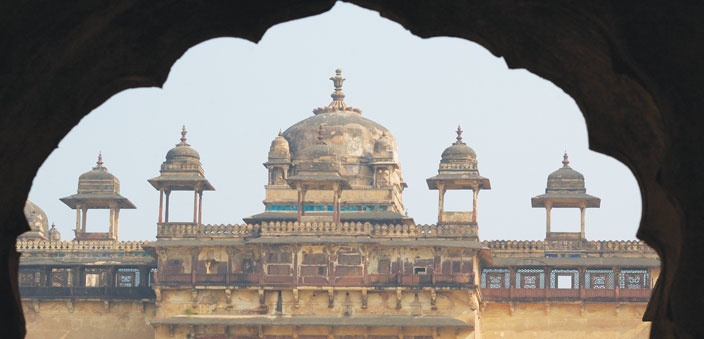
As darkness enveloped the sky, we walked down the dimly-lit main street of the town, back to our Betwa cottages overlooking the chuckling Betwa River. The air was fragrant with the aroma of wood smoke. We cast furtive glances at the brooding palaces wrapped in mystery, and the almost impenetrable dark of the night; and avoided the groups of locals sitting on their haunches as they gossiped in the shadow of a flickering paraffin lamp.
Exploring the hidden treasures of the town the next day, confirmed our growing suspicion that Orchha had fallen out of a gingerbread world. Its startling beauty and awesome architecture made it more than just another pretty place. Though a mere 12 km south of Jhansi, and within striking distance of Gwalior, Orchha seems almost cut off from mainstream India. Some two sq km in area, it had been virtually swallowed by the dry deciduous jungle surrounding it when it was re-discovered as a tourist spot.
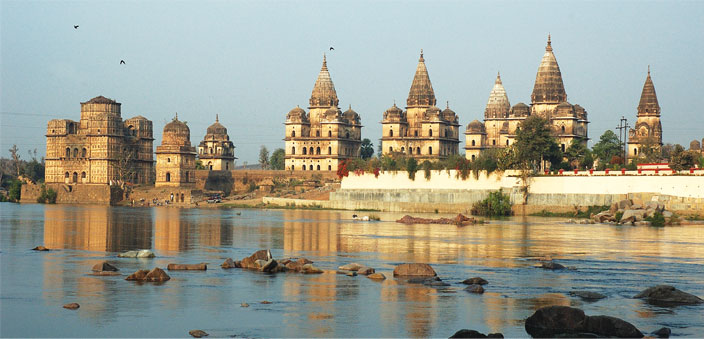
The town seems to have an almost dual character – illusions of grandeur drawn from a royal past combine with the rusticity of a tiny hamlet of 5,000 people. The halwai and the bania ply their trade in the shadow of weathered and mysterious monuments, and we got a strong feeling here, in the lanes and by-lanes that little has changed over the eons. Orchha is a beguiling town which seems to be almost proud of its isolation and relative obscurity, mused a French guide Jean Christophe Benghabrit whom we met while he was shepherding his tiny flock, some of whom had made as many as seven trips to India, around Orchha. As we spoke, a yokel accosted us, and with the simplicity of his ilk told us that he would like his picture taken with us. When he heard that we were from Mumbai, he pumped our hands in welcome and asked us if we knew Shah Rukh Khan and Aishwarya Rai.
This rustic simplicity was evident everywhere…No one pursued us around for alms, chocolates or pens. Here, tourists are treated as guests, rather than an industry. For, life flows as serenely as the Betwa in this little self-contained hamlet which only the restless and the ambitious leave in search of opportunity in the big bad world outside its confines.
Origin of Orchha
Dotted with 32 monuments, the medieval city wears its years with the aplomb of a blue-hair- rinsed dowager who has aged gracefully. And each of these monuments has its own story to tell; stories that don’t get jaded with repetition. Orchha was founded in the sixteenth century by the Bundela Rajput chieftain Rudra Pratap, who fell in love with this stretch of land along the Betwa River. He considered it an ideal site for his capital as it was situated in countryside so scenic, it made his heart sing.
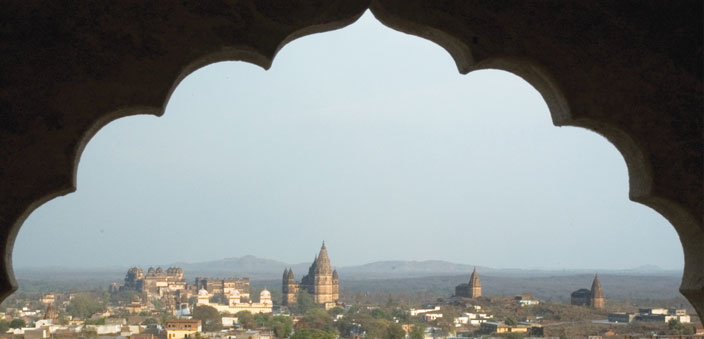
Of the succeeding rulers, the most notable was Raja Bir Singh Ju Deo who built the exquisite Jehangir Mahal in the 17th century to house the crown prince of the Mughal empire and his entourage. The man who would later become the fourth Mughal Emperor of India had an army of 12,000 in tow, and his task was to impress upon his host the need to swear lifelong allegiance to his father Akbar. After the royal guest checked out, the three-tiered palace crowned by graceful chhatries was abandoned and left to languish in the sun like a jilted lover.
We strolled through the sad and lonely palace that loomed above us, its balconies, grilled windows and stone elephants exuding a sense of stolidity. The strong lines of this rectangular structure were counterbalanced by delicate chhatries and trellis work before screeching bats chased us out of what was once a princely oasis.
Imposing Raj Mahal which rises across a yawning courtyard was built by Madhukar Shah, the deeply religious predecessor of Bir Sing Ju Deo, and it was here that all the kings of the Bundela dynasty lived. The palace that saw a succession of kings and queens preside over Orchha was the heartbeat of the little kingdom. It was a hotbed of political intrigue, unbridled ambition, treachery, lust and love…The plain façade of the monument contrasts with the rich murals within. A ceiling resembles a carpet of flowers; bedrooms vibrant with frescoes of Krishna with his gopis; vignettes of daily life of kings and commoners…A zenana filled with memories of gorgeously clad, blushing princesses, while negotiations for their marriages to distant princes were being firmed up. And we could imagine rebellions being ruthlessly stamped out and wars being plotted, even as long-widowed great-aunts peeped out from far-flung turrets.
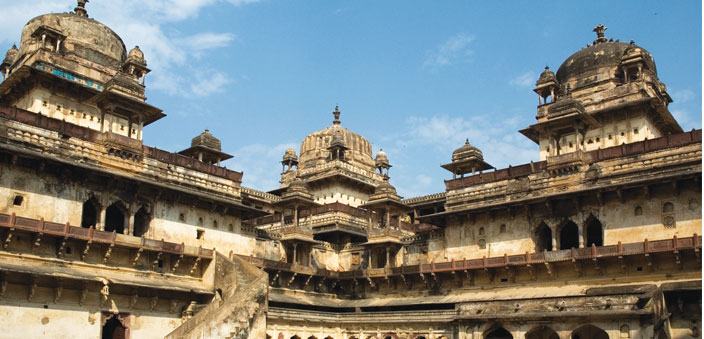
It was easy to believe that ghosts haunted this unreal fairy tale world of bejewelled princes and princesses, nautch girls and pampered concubines. Our guide fed our fantasies when he told us about a resident ghost who still wanders around the palace disconsolately. A chowkidar had claimed that his throat had been clutched in a vice-like grip by a hand that appeared out of thin air. The apparition is believed to be of a two-timing dancing girl who had been caught by one of her lovers and killed in a moment of rage. We felt like we were strolling through a haunted house.
The Rai Praveen Mahal completes the group of palaces in this complex. This petite two-storied structure which blends seamlessly with the surroundings was believed to be built by Raja Indramani (1672-76) for his beautiful mistress Rai Praveen.
When Emperor Akbar heard about her legendary beauty he wanted to possess her and summoned her to Delhi. Raja Indramani was torn between wanting to comply with the Great Mughal’s wishes, and his love for his prized concubine; our guide related the story with the air of one who knew the lead characters of the story personally. She convinced her king that if he let her go, she would return untouched by the emperor. So the beautiful damsel went to the court of Akbar with great pomp. There, the Mughal who had heard that she had both beauty and brains asked her to recite a poem. She obliged with a poignant one which conveyed her dilemma. Tell me Emperor: who but a dog or a crow eats someone’s leftovers? The emperor got the message and let her return to her king and lover – untouched.
Orchha’s temples
Leaving behind this world of royalty and nautch girls, we crossed the Betwa River and strolled past the Chaturbhuj Temple which broods over the town’s bustling marketplace. The temple is an imposing structure all right, but what makes it unique is that it stands empty and forlorn, grieving over the fact that the divine guest for whom it was built never graced its altars.
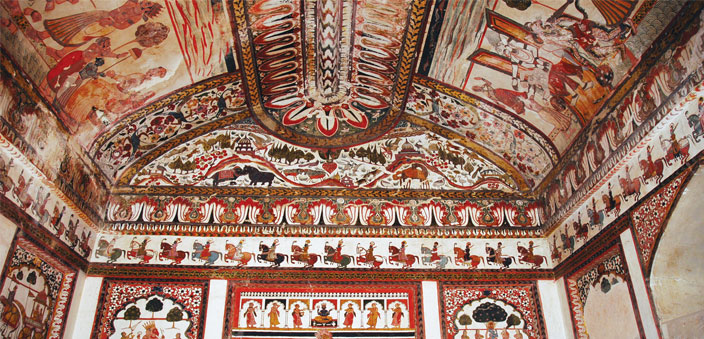
The story told is that many centuries ago, Rani Kunwar had set off on a pilgrimage visiting all the sites that were linked to the life of Lord Ram in the hope that the lord would one day reward her devotion with his presence. Distressed that Lord Ram was proving elusive, she attempted suicide by jumping into the Saryu River. Luckily she was pulled out of the water by one of her maids. The next day an idol of Lord Ram mysteriously appeared in her room. The same night she had a dream in which the lord told her to ferry the idol back to Orchha. However, he cautioned her to be careful: the idol had to be carried at all times, and the moment it was put down it would not budge, and that would be its final resting place.
Immediately the queen set off on her return journey, which in those days took eight months. Meanwhile, her doting husband King Madhukar Shah started to build the Chaturbhuj Temple to receive Lord Ram when He arrived. However, the temple could not be completed in time, and on the arrival of his wife’s entourage, the king ordered the idol of Lord Ram to be placed in her bedroom till such time it could be enshrined in the temple. When it was time to shift the deity to its new home, the idol stubbornly refused to budge no matter how many hands tried to lift it. And so it remained where it was, in a small room of the palace which was later converted into the Ram Raja Temple. Built in the Nagara style, it has a tall central spire and a square layout. The exterior is ornate with lotus emblems and other symbols of religious significance. Within, the sanctum is simplicity itself, with high vaulted walls emphasising its deep sanctity.
Excursions from Orchha
Sonagiri: The divine goal
We were caught in a rural traffic jam on the last leg of our journey to the Jain temples of Sonagari, some 45 km north of Orchha, in Madhya Pradesh. The narrow little village road was blocked by a flock of sheep and their shepherd seemed to be in no hurry to move them to the embankment and let us through.
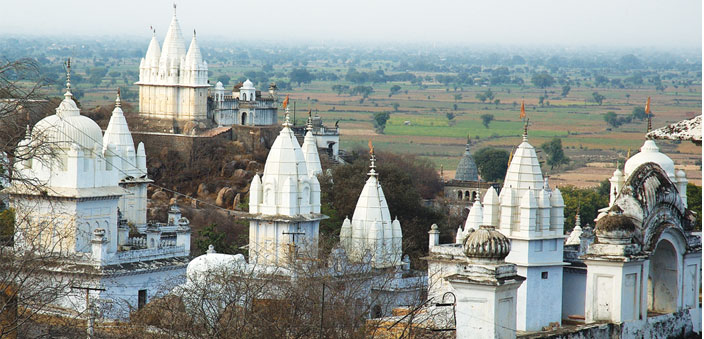
In the distance, a cluster of white temples beckoned through the false dusk created by the cloud of dust thrown up by the jostling animals. By the time we reached the entrance of the complex, the 77 temples that sprawled out across the face of the holy hillock glowed gold-orange in the warm rays of the setting sun.
Soon we were trekking up a paved pathway that wound past shrines and temples, some delicate and small and others, grand and imposing Suddenly, a flock of wild peacocks fluttered by and perched themselves on the higher reaches of the monuments as though to catch a more compelling view of the sunset; their long graceful tails draped like elegant ornaments across the spires and domes of the temples. It was almost as though the gods had conspired to arrange an appropriate welcome for our visit to Sonagari or the golden peak.
Sonagari is an important pilgrim stop on the Digambar Jain circuit as it is where King Nanganag Kumar, along with 15 million of his followers, is believed to have attained nirvana. Ever since, ascetics and pilgrims have flocked here in the hope that it will speed them on to their final release from the cycle of life and death. The first temple to be built here dates back to the 12th and 13th centuries and, over the years, members of the Jain community have added new monuments to the hill – either as an expression of their devotion, or as a token of thanks for favours granted.
Sculpted elephants trumpeted a silent welcome as we walked through this chorus of piety expressed in stone, and we could not help but notice that a few of them had been scarred by time and the elements.
Closer to the summit, we came upon a sprawling courtyard encircled with marble shrines that blushed with the kiss of the dying rays of the sun. In the middle, a sculpted pillar surged towards the heavens like a silent prayer. Finally we reached the main temple – number 57 – within which an 11 ft statue of Lord Chandraprabhu, the eighth Tirthankar who visited Sonagari 17 times, is enshrined.
After making our offerings and invoking divine blessings, we retraced our steps, stopping briefly to tap on a slab of stone that is called Bajani shila for the simple reason that when struck it produced a metallic resonance.
Before proceeding on our journey back to our base in Orchha, we took time out to visit the Sheesh Mandir or glass temple which is the most striking of the 24 additional temples at the foot of the hill. Judging from its outer walls, there was nothing to suggest that this place was special. The inner sanctum of the shrine, however, was surreal: a mosaic of colourful glass reflected the flickering flames that danced on the lips of clay diyas. The fact that we spent more time here than we had budgeted for did not matter, for we felt we were truly blessed to have been enveloped in an aura of divinity.
Fact File
Sonagari lies 45 km north of Orchha and 5 km from Datia. It has its own station, but few trains stop here. Jhansi, 31 km to the south, is a more convenient railhead. By way of accommodation one can stay at a number of Jain dharamsalas at Sonagari, but must adhere to their strict religious requirements that include no smoking, no alcohol and no meals between sunset and sunrise. There are no tourist class hotels at Sonagari.
Soulful and beautiful Datia
Datia did not figure in our Madhya Pradesh itinerary. And when we first saw it framed in the window of our compartment on the train – a small settlement with a grand palace like building – none of our co-passengers could identify it. We dismissed it as another of the many heritage and cultural gems lost in the vast Indian landscape. However, when we ran into French tourists staying at our hotel in Orchha and heard them raving about the palace in Datia – ‘exquisitely beautiful,’ they said, kissing their fingers in appreciation – we knew that we had to fit it into our schedule.
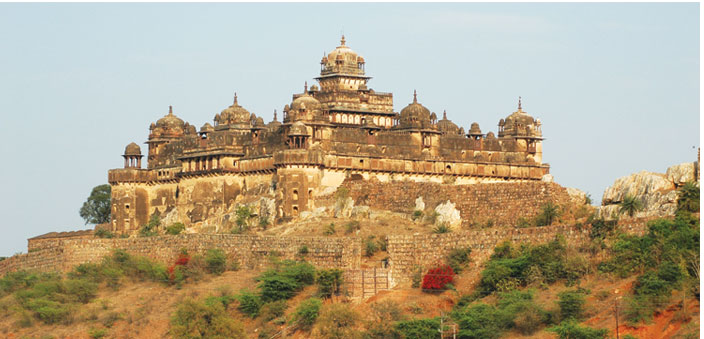
And we were thankful we did. Our first stop was at the Madhya Pradesh cottage complex built along the banks of a lazy river which had a grandstand view of the seven-storey Datia palace, which straddled a little hillock like an all-conquering monarch. However, we first had to navigate a network of small alleyways that eventually led us to the entrance of the palace complex. Here we recruited the services of a local guide and set out to explore a grand monument that by a quirk of fate was never occupied except by the legends that still reside within its limestone walls.
The story goes that Prince Salim, the eldest son of Mughal Emperor Akbar and later known as Emperor Jahangir, had a falling out with his father thanks to the scheming of Akbar’s right hand man, General Abul Fazal. So when the young and ambitious prince heard that the troublemaker Abul Fazal would be passing through Datia, he leaned on the ruler of the region Raj Bir Singh Deo to eliminate the general. The local ruler duly obliged and had Abul Fazal killed.
When Salim eventually ascended the throne, Raj Bir Singh Deo invited the newly crowned emperor to visit his kingdom. But first he built a 400-room palace that embraced Hindu, Islam and Mughal architectural styles to accommodate his royal guest. But the Emperor knew that the price of gratitude for a favour done would be high. So he found some excuse or the other not to make the journey. Later, of course, he was way too intoxicated with opium, poetry and his queen Noor Jehan (who anyway ruled the empire by proxy) to care.
As a result, the 16th century palace lay empty, waiting for a royal guest who never arrived. Time and the elements took its toll, and today the hint of turquoise blue tiles on the filigreed bands that run around blackened domes, corridors of ageing pillars, tired brackets under jaded balconies and the broken-tooth smile of damaged screens, hint at the past splendour of the building. We walked through this sad and lonely structure, admiring its ornamental ceilings and the few graffiti scarred murals and frescos that an ungrateful emperor never came to admire. Our guide drew our attention to the nodes atop the fretted screens of the balconies that had been sawed off. According to him, Raj Bir Singh Deo had embedded a diamond in each of these posts so that the womenfolk accompanying his royal guest could entertain themselves playing treasure hunt; the winner being the one who found the largest gem. Over the years other treasure hunters roamed through the palace breaking off the nodes; whether they found diamonds or not no one knows for certain.
Unlike other palaces that are filled with the ghosts of the past, here the footsteps of visitors echo through the hallways disturbing the wraith-like spectres of the thousand labourers who toiled over the construction of a monument, that eventually served no purpose.
Across the town, the spires of chhatris or memorials to past rulers of the region rose in silent benediction, towards the heavens. We finally returned to our vehicle and set off for our base, in the more touristy town of neighbouring Orchha. Behind us, the Datia palace leaned against the horizon: empty but for a sad story of broken promises that fills it like an exclamation mark!
File Facts
Datia lies 40 km north of Orchha, and 5 km south of Sonagiri. Jhansi, 26 km to the south, is the closest station. By way of accommodation, Madhya Pradesh Tourism runs Datia Tourist Motel – with an attached restaurant – on the river banks opposite the Datia palace. There are a few other options, but most of these are of indifferent standards.
Whatever happened to the Chaturbhuj temple? It stands forlorn and empty, probably brooding over its sad karma and what might have been.
We left behind the market place buzzing with life, in an autorickshaw. We headed for the imposing hilltop Laxminarayan Temple that stands on the outskirts of the town like a sentinel keeping a watchful eye on the town. Here, the interiors were alive with colourful murals that artists had plucked out of the holy scriptures as also the everyday life around them. Gods and goddesses frolicked, decimated demons and battled mythical monsters. While the colours retain their vivacity, many of the murals have been defaced by graffiti.
By the time we emerged on the balcony of the temple, the scattering of clouds in the sky above us were painted orange and gold by the setting sun. The sprinkle of ancient monuments across Orchha took on an ethereal glow. This little historic outpost could well have existed in a fairy tale world, almost divorced from reality.
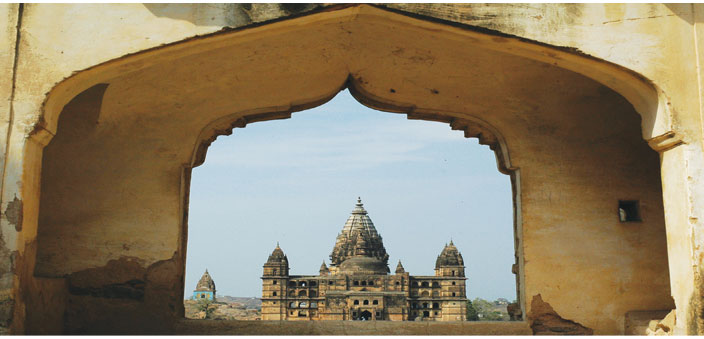
Early next morning we were off on a safari into the Orchha Wildlife Sanctuary, a 44 sq ft island marooned in the Betwa River. The nature park, once the hunting ground of royalty, used to bristle with tigers, bears and other species of mammals, lizards and birds. Sadly, the sanctuary was stripped of much of its big game, but we did get to see nilgai, spotted deer, monkeys, a monitor lizard with a darting tongue and a peacock dancing for its coy mate, which was probably hiding behind a bush.
After the close encounters with native wildlife, we stopped by to pay homage to the dead: 14 cenotaphs of the rulers of Orchha, wrapped in quietude as they contemplated their reflections in the twisting Betwa River. They somehow exuded a haunting quality that suggested that Orchha is a huge open-air museum full of architectural masterpieces. Gazing across the plains, the stones seemed to speak and we wondered about the secrets they guarded.
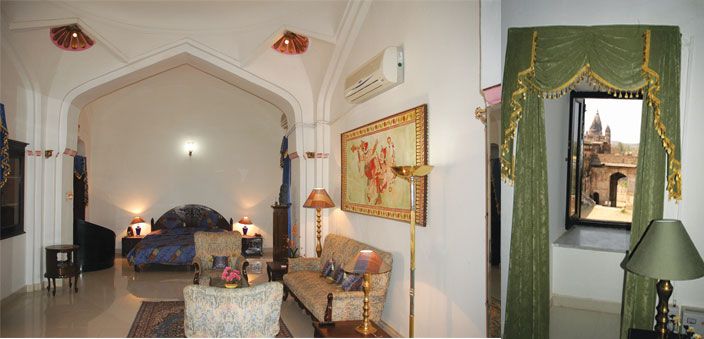
It was our last evening in the hamlet and we sat by the chortling Betwa River, watching a herd of goats being shepherded across a picturesque little bridge by a cherubic little boy. The hills in the background were flecked with the gold of a setting sun. The breeze carried with it the melody of chattering crickets — the most evocative sound in the world. Couples and families had spread picnic hampers by the river and seemed locked in circles of love. The night slammed down quickly and we retreated to the shelter of our Betwa cottages.
The next day when we travelled to Jhansi railway station, we felt like we had been catapulted into the real world with all its uncertainties, suffering and pain. Waiting for our train to chug into the platform, we remembered Orchha, its proud history and weathered monuments, and the warmth of its welcome. The longer you stay in Orchha, replete as it is by the ghosts of royal lovers, the more difficult it is to remember that you are living in the 21st century.
Fact File
Orchha is one apex of the Madhya Pradesh tourist triangle which includes Gwalior and Shivpuri. Gwalior, 124 km away, is the nearest airport. Jhansi, 16 km, is the nearest railway station. Pre-paid autos (available at a stand outside the station) charge a fixed amount for the 40-minute ride to Orchha. State Transport buses are also available.
Madhya Pradesh Tourism runs two hotels in Orchha: Betwa Cottages and Sheesh Mahal Palace Hotel. In addition, there are a number of other options in the 1 to 3 star category. For more information visit MP Tourism at: https://www.mptourism.com

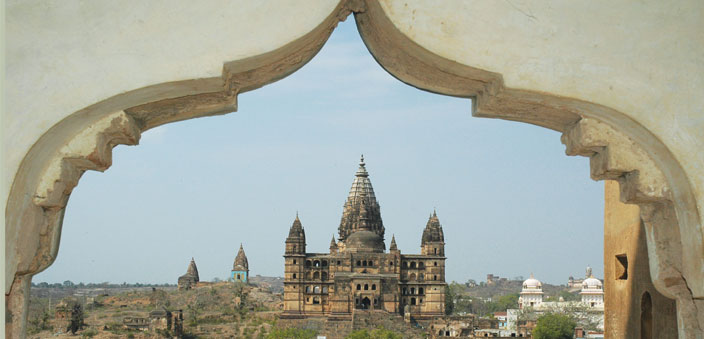
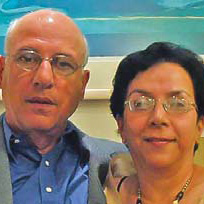 [/column]
[/column]